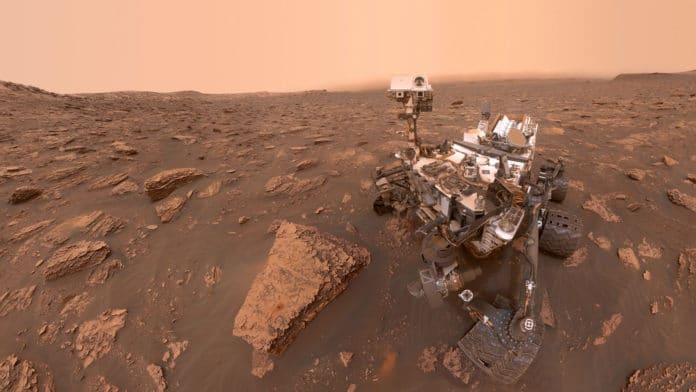The topic: ‘Methane on mars’ has gathered scientists’ interest, as its presence may indicate the presence of microbes on the Red Planet. Although methane has nothing to do with microbes, it is produced by the geological processes that involve the interaction of rocks, water, and heat.
Methane on Earth is special. Of the 1,750 parts per billion by volume (ppbv) of methane in Earth’s atmosphere, 90 to 95 percent is biological in origin.
On Mars, instruments like NASA’s Curiosity rover have detected the methane gas right above the surface of Gale Crater. However, another instrument like ESA’s (the European Space Agency) ExoMars Trace Gas Orbiter hasn’t detected any methane higher in the Martian atmosphere.
Why does this happen? Why some instruments detect the gas while others don’t?
In 2016, Tunable Laser Spectrometer (TLS) on NASA’s Curiosity Mars Rover was expected to report about the presence of a small amount of methane everywhere on Mars. The TLS has estimated less than a one-half part per billion in the volume of methane on average in Gale Crater. These estimations have been accentuated by baffling spikes of up to 20 sections for every billion in volume.
On the other hand, ExoMars Trace Gas Orbiter was designed to measure methane and other gases over the whole planet. At the same time, Curiosity’s TLS is so precise, but it was quite surprising to know that ExoMars Trace Gas Orbiter detects no methane.
Jolted by European orbiter findings, scientists immediately decided to study the TLS measurements on Mars.
According to some experts, the Mars rover itself was releasing the gas. Hence, scientists detected the correlations with the pointing of the rover, the ground, the crushing of rocks, the wheel degradation – you name it.
Planetary scientist John E. Moores from York University in Toronto published an intriguing prediction in 2019. “I took what some of my colleagues are calling a very Canadian view of this, in the sense that I asked the question: ‘What if Curiosity and the Trace Gas Orbiter are both right?'”
Along with Moores, other Curiosity team members studying wind patterns in Gale Crater suggested that the difference between methane measurements arose due to the time of day they’re taken.
TLS needs a lot of power to operate, especially at night, when no other Curiosity instruments work.
Moores noted, “The Martian atmosphere is calm at night, so the methane seeping from the ground builds up near the surface where Curiosity can detect it.”
“The Trace Gas Orbiter requires sunlight to pinpoint methane about 3 miles, or 5 kilometers, above the surface. Any atmosphere near a planet’s surface goes through a cycle during the day. The heat from the Sun churns the atmosphere as warm air rises and cool air sinks. Thus, the methane that is confined near the surface at night is mixed into the broader atmosphere during the day, which dilutes it to undetectable levels.”
“So I realized no instrument, especially an orbiting one, would see anything.”
Immediately, the Curiosity team decided to test Moores’ prediction by collecting the first high-precision daytime measurements. TLS measured methane consecutively over one Martian day, bracketing one nighttime measurement with two daytime ones.
With each experiment, SAM sucked in Martian air for two hours, continuously removing the carbon dioxide, which makes up 95% of the planet’s atmosphere. This left a concentrated sample of methane that TLS could easily measure by passing an infrared laser beam through it many times, one that’s tuned to use a precise wavelength of light that is absorbed by methane.
Paul Mahaffy, the principal investigator of SAM, who’s based at NASA’s Goddard Space Flight Center in Greenbelt, Maryland, said, “John predicted that methane should effectively go down to zero during the day, and our two daytime measurements confirmed that. TLS’s nighttime measurement fit neatly within the average the team had already established. “So that’s one way of putting to bed this big discrepancy.”
While this study suggests that methane concentrations rise and fall throughout the day at the surface of Gale Crater, scientists have yet to solve the global methane mystery on Mars.
Experiments are underway to test whether very low-level electric discharges induced by dust in the Martian atmosphere could destroy methane or whether abundant oxygen at the Martian surface quickly destroys methane before it can reach the upper atmosphere.
Journal Reference:
- Christopher R. Webster et al. Day-night differences in Mars methane suggest nighttime containment at Gale crater. DOI: 10.1051/0004-6361/202040030
